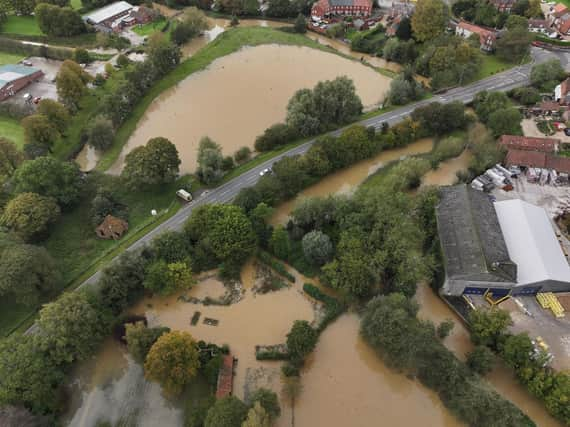Horncastle flooding 'not caused by delay closing the sluice gate' but an 'extreme flood', says Environment Agency


Storm Babet brought two month’s worth of rain between October 19 and 20 last year, causing flooding and damage to nearly 200 homes in town, plus 31 properties in Kirkby-on-Bain, as river levels rose.
In its initial report published in November 2023, the Environment Agency (EA) explained that a sluice gate which failed to close automatically to prevent Horncastle from flooding was not operated manually until nearly 12 hours later.
Advertisement
Hide AdAdvertisement
Hide AdBut now the Environment Agency has released its report, which stated that the flooding was caused by “extreme” flooding due to heavy rainfall over catchment areas downstream of the reservoir in Hemingby, which was more than the scheme was designed to take – not the delay in closing the sluice gate.
The Horncastle Flood Storage Reservoir was completed in 2017 to reduce flood risk along the River Bain in Horncastle and surrounding villages downstream, and was designed to reduce the flood risk along the River Bain in
Horncastle to a one in 100 chance in any year – but the report stated that Storm Babet brought a far greater flood event, with a one in 1,000 chance in any year – an “extreme flood”.
The report, overseen by the Environment Agency’s Chief Engineer, has said that as the levels on the River Bain began to rise in the early hours of October 20, a message was sent by the telemetry system at 3.23am to say the river had reached a level where the sluice gate should close.
Advertisement
Hide AdAdvertisement
Hide AdIt is designed to close automatically several hours before needed, to allow time for it to be closed manually if required, but on this occasion, it was 11.45am when the flow reached the threshold where the sluice gate needed to be fully closed.
It was thought the sluice gate was in automatic mode and therefore would have closed, but it was later discovered that there was an issue with the controls of the sluice gate and a system setting had overridden the gate to manual mode.
At 7.17am, the duty team were contacted to check the gate, but this didn’t happen as the flooding worsened across the county.
A landowner reported that the sluice gate was still open at 12.41pm, but due to flooding on the roads, staff were delayed to the site and the sluice gate wasn’t closed until 2.15pm – 11 hours after the system first reported that the gate should be closed.
Advertisement
Hide AdAdvertisement
Hide AdThe EA report stated that additional computer modelling of the catchment was carried out to see whether the flooding would have been slowed down had the sluice gate been opened sooner, but it said that earlier closure of the sluice gate may have delayed the river reaching this peak by just over an hour.
The report also said that modelling has confirmed that even if the sluice gate had been closed earlier, properties alongside the River Bain would still have flooded because the heaviest rain fell downstream of the reservoir.
The modelling has also confirmed the initial findings that flooding along Thunker Drain and the River Waring was not related to the sluice gate at the reservoir, but due to the quantity of rainfall – the highest levels for more than 30 years.
The EA’s report concluded that the investigation has identified issues with the sluice gate operating system, and that several improvements could be made to improve the gate’s reliability.
Advertisement
Hide AdAdvertisement
Hide AdThe report concluded: “The Environment Agency will continue its ongoing dialogue with the community to see if there is anything additional that can help reduce flood risk through the town, including raising awareness of flood risk and how people can be prepared.
“The learning from this incident will be shared and implemented across the Environment Agency for all assets.”